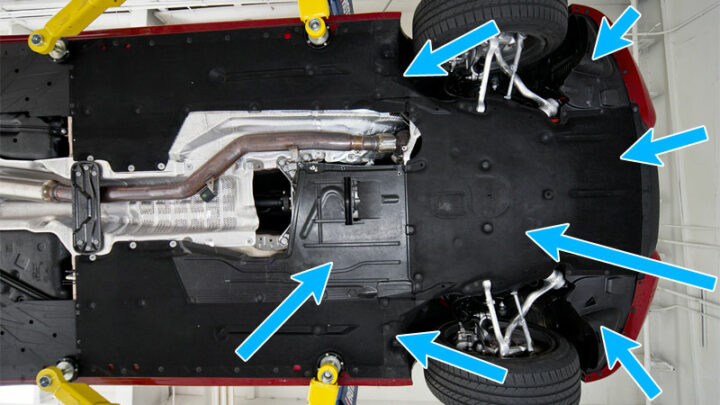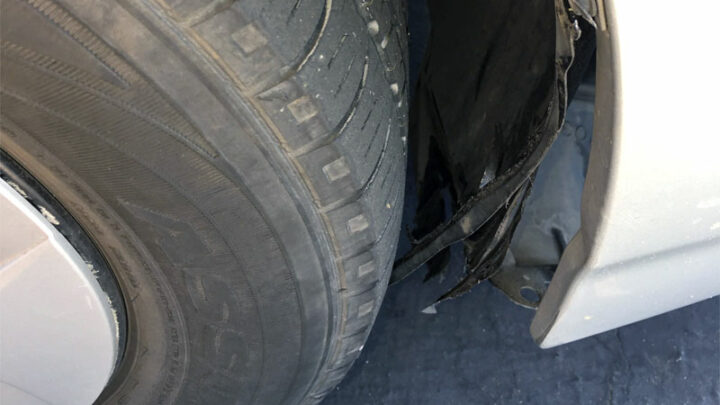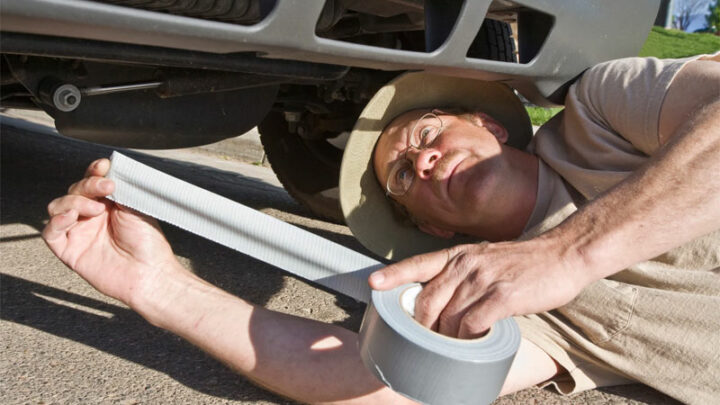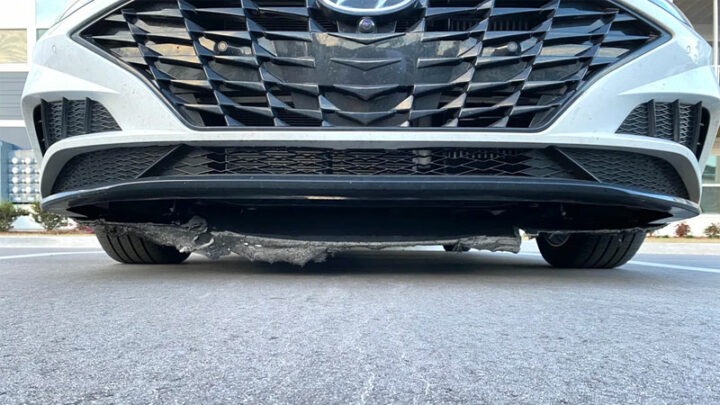Plastic Piece Dragging Under Your Car? (What It Is and What To Do)
You’re driving along when suddenly you hear what sounds like a plastic piece dragging underneath your car. Your mind races with questions… What is it? Is it safe to keep driving? How do I fix it?
Keep reading to learn how to identify the problem, assess its severity, and determining the best course of action to get you back on the road safely.

Identify the Source of the Dragging Sound
When you hear a plastic piece dragging under your car, you first need to find the source. It could be one of many plastic components underneath and some vehicles have more components than others. Here are the most common:
- Undercarriage shields – These plastic panels protect the underside of your car from road debris and help with aerodynamics. If they become loose or damaged, they can drag on the ground and sometimes even make a whistling sound as air passes over them while driving.
- Bumper covers – The plastic covers on your front and rear bumpers can sometimes come loose and scrape against the road surface.
- Wheel well or fender liners – These plastic liners sit inside your wheel wells and protect the fenders from debris kicked up by the tires. If they get damaged or dislodged, they may cause a dragging noise.
To figure out the source of the dragging noise, you’ll need to take a look underneath your vehicle. Those with a high vehicle clearance like a pickup truck or SUV will find it a lot easier than someone with a sporty car that sits low to the ground. Here’s how to do it safely:
- Find a level spot to park your car, such as a driveway or parking lot.
- Engage your parking brake to prevent any chance of the car rolling while you’re inspecting it.
- Get down on the ground and use a flashlight to look for any hanging or damaged plastic pieces. Be sure to check near the front and rear bumpers, wheel wells, and the center of the undercarriage.

Determine the Severity
After identifying what’s causing the dragging noise, you’ll need to assess how serious the issue really is. There are two main categories of problems: minor issues and major issues.
Minor Issue
Less severe issues are those that don’t pose an immediate risk to your safety or your vehicle’s performance. They may however cause an annoyance or embarrassment to you, your passengers, and those around you as you drive.
If a small, non-essential plastic piece, such as a fender liner or undercarriage shield, is hanging down slightly but not making contact with the ground (unless you go over a speed bump or something), it may not require immediate attention.
If the dragging piece is not affecting your ability to steer or brake, and it’s not at risk of coming loose entirely, you may be able to continue driving cautiously until you get a chance to fix the problem.

Major Issue
With a severe issue, immediate attention is required as it may make it unsafe to continue driving your vehicle.
If a large plastic piece, such as a bumper cover or a significant portion of an undercarriage shield, is dragging on the ground, it could cause damage to other components or create a hazard for other vehicles on the road.
If the dragging piece seems likely to detach completely, it could cause you to lose control of your vehicle or create an obstacle for other drivers, potentially leading to an accident.
If you’re dealing with a minor issue, you may be able to address it with a temporary fix. However, if you’re facing a major issue, you’ll want to avoid driving your vehicle until the problem can be resolved.
Related: How Much Does Repainting a Bumper Cost?
Temporary Fixes For Minor Issues

If you’ve determined that the dragging plastic piece is a more of an inconvenience than anything else, there are a couple of temporary fixes you can try to secure the piece and minimize further damage.
Secure With Zip Ties or Duct Tape
One quick and easy solution is to secure the loose plastic piece to a stable part of the undercarriage using zip ties and/or duct tape. If done correctly, this will prevent the piece from dragging on the ground and potentially causing additional damage.
Just keep in mind that this is only a temp solution, and you should still have the component in question properly reattached or replaced (if damaged).
Remove the Piece
In some cases, you may be able to simply remove the damaged plastic piece entirely if it’s not essential to your vehicle’s function or safety.
For example, if a small portion of a fender liner has come loose and is dragging, you might be able to cut off the damaged section (tin snips work well) without compromising the liner’s overall effectiveness.
That said, be cautious when removing any parts, as some plastic components may play a more important role than you may think.
Remember, even if you’re able to temporarily fix the issue to stop the dragging, it’s still a good idea to take your vehicle into the shop to have it inspected and even properly repaired. The engineers who created your car put that plastic piece there for a reason.
Addressing Major Issues

If you’ve determined that the dragging plastic piece is pretty severe, immediate action will be necessary.
Stop Driving
If the dragging plastic piece is causing significant damage or poses a risk to your ability to control the vehicle safely, do not continue driving. Continuing to drive with a severe issue could lead to accidents, injury, or more extensive damage to parts of your vehicle.
Call a Tow Truck
In cases where it’s unsafe to drive (such as a dragging bumper), your best bet is to have your vehicle towed to a qualified mechanic or repair shop. Many auto insurance policies include roadside assistance and towing coverage, so check with your provider to see if this applies to you. If not, you may need to arrange for a private tow truck to transport your vehicle.
Repair or Replace the Damaged Component
Once your vehicle is at the shop or dealership, a professional technician will assess the damage and recommend the appropriate course of action. In most cases, this will involve replacing the damaged plastic component, although repair may be possible in some cases.
Depending on the extent of the damage and the specific part involved, this repair could be relatively simple and inexpensive, or it may require more extensive work.
Common Causes of a Dragging Plastic Piece

One of the most common causes of damage to plastic undercarriage components is road debris and impacts.
When you drive over potholes, speed bumps, or other obstacles, the impact can cause plastic pieces to crack, break, or come loose from their mounting points. Debris kicked up from the road, such as rocks or branches, can also strike plastic components and cause damage.
Even if you avoid significant impacts, plastic components can still deteriorate over time due to normal wear and tear.
Exposure to the elements, such as UV rays, extreme temperatures, and moisture, can cause plastic to become brittle and more prone to cracking or breaking. Additionally, vibrations from normal driving can cause mounting points to loosen over time, allowing plastic pieces to sag or come loose.
In some cases, a dragging plastic piece may be the result of bad install job or repair.
If a plastic component is not securely fastened during installation or after a repair, it may come loose and start dragging on the ground. This is why it’s important to have any work on your vehicle performed by a qualified professional who follows proper procedures and uses the correct parts and tools.
Of course, accidents and collisions can also cause damage to plastic undercarriage components. Even a minor fender bender can cause a bumper cover or fender liner to come loose or get damaged. In more severe accidents, plastic pieces may be torn off completely or shattered, requiring replacement.
See Also: How to Tell If Your Car Has Frame Damage
Preventing Future Occurrences
If you’ve already gone through and fix the problem, there are a few things you can do to prevent this from happening again in the future.
The best thing you can do to prevent problems with your vehicle’s plastic components is to keep up with regular maintenance. This may include routine inspections of your undercarriage, bumpers, and wheel wells to identify any potential issues before they become serious problems.
In addition, careful driving habits can help protect your vehicle’s plastic components from damage. This typically includes avoiding potholes and debris and driving slower over rough roads. This is easier said than done in some parts of the country where road maintenance seems to be an afterthought, but your undercarriage (and suspension components) will thank you.
If you hear any new or unusual noises coming from your vehicle, don’t ignore them. These sounds are often early warning signs of a problem with your plastic components or another part of your vehicle. Catching these issues early will often prevent costly repairs later on.
- Replace the Engine or Replace the Car? (11 Factors to Consider) - Apr 11, 2024
- Plastic Piece Dragging Under Your Car? (What It Is and What To Do) - Mar 21, 2024
- Timing Belt vs Timing Chain (What’s the Difference?) - Feb 27, 2024
